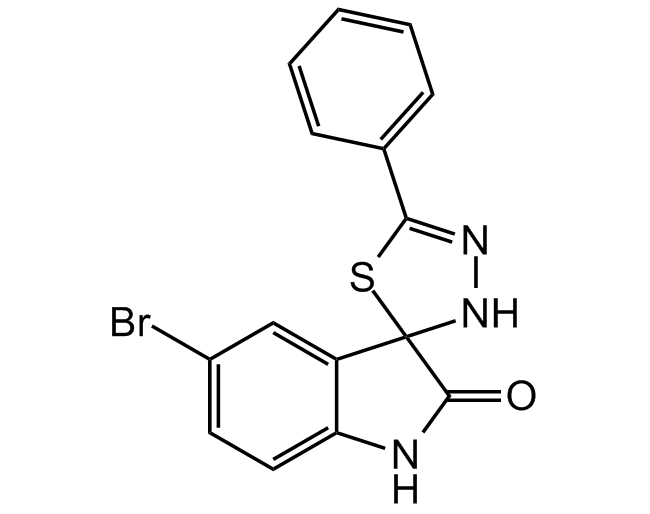
Chemical Structure
Lipofermata
AG-CR1-3542
CAS Number297180-15-5
Product group Chemicals
Estimated Purity>98%
Molecular Weight360.2
Overview
- SupplierAdipoGen Life Sciences
- Product NameLipofermata
- Delivery Days Customer10
- CAS Number297180-15-5
- CertificationResearch Use Only
- Estimated Purity>98%
- Molecular FormulaC15H10BrN3OS
- Molecular Weight360.2
- Scientific DescriptionChemical. CAS: 297180-15-5. Formula: C15H10BrN3OS. MW: 360.2. Lipofermata is an inhibitor of fatty acid transport, blocking fatty acid transport protein 2 (FATP2), and was identified afterwards as a FATP1 inhibitor as well. Inhibition was specific for long and very long chain fatty acids but not medium (C6-C10) fatty acids in myocytes (mmC2C12), pancreatic beta cells (rnINS-1E), intestinal epithelial cells (hsCaco-2) and hepatocytes (hsHepG2), as well as primary human adipocytes. The fatty acid transport proteins (FATP), when localized to the plasma membrane or at intracellular membrane junctions with the endoplasmic reticulum, function as a gate in the regulated transport of fatty acids and thus represent a therapeutic target to delimit the acquisition of fatty acids that contribute to disease as in the case of fatty acid overload, such as obesity, Typ 2 diabetes or cancers. Lipofermata prevented palmitate-mediated oxidative stress, induction of BiP and CHOP and cell death in a dose-dependent manner in hsHepG2 and mINS-1E cells suggesting utility in preventing fatty acid-mediated cell death pathways and lipotoxic disease. FATP2 selectively allows for the accumulation of arachidonic acid, which is needed for the cells to make prostaglandin E2 (PGE2), a potent inflammatory molecule that is also implicated in the immunosuppressive activity of MDSCs in cancer. Pharmacologic blockade of FATPs with the small molecule inhibitor Lipofermata abrogates lipid transport into melanoma cells and reduces melanoma growth and invasion. In combination with checkpoint inhibitors, FATP2 inhibition blocked tumor progression in mice. Lipofermata also shows inhibitory activity against ADAMTS-5 (Aggrecanase-2) with potential use in osteoarthritis. - Lipofermata is an inhibitor of fatty acid transport, blocking fatty acid transport protein 2 (FATP2), and was identified afterwards as a FATP1 inhibitor as well. Inhibition was specific for long and very long chain fatty acids but not medium (C6-C10) fatty acids in myocytes (mmC2C12), pancreatic beta cells (rnINS-1E), intestinal epithelial cells (hsCaco-2) and hepatocytes (hsHepG2), as well as primary human adipocytes. The fatty acid transport proteins (FATP), when localized to the plasma membrane or at intracellular membrane junctions with the endoplasmic reticulum, function as a gate in the regulated transport of fatty acids and thus represent a therapeutic target to delimit the acquisition of fatty acids that contribute to disease as in the case of fatty acid overload, such as obesity, Typ 2 diabetes or cancers. Lipofermata prevented palmitate-mediated oxidative stress, induction of BiP and CHOP and cell death in a dose-dependent manner in hsHepG2 and mINS-1E cells suggesting utility in preventing fatty acid-mediated cell death pathways and lipotoxic disease. FATP2 selectively allows for the accumulation of arachidonic acid, which is needed for the cells to make prostaglandin E2 (PGE2), a potent inflammatory molecule that is also implicated in the immunosuppressive activity of MDSCs in cancer. Pharmacologic blockade of FATPs with the small molecule inhibitor Lipofermata abrogates lipid transport into melanoma cells and reduces melanoma growth and invasion. In combination with checkpoint inhibitors, FATP2 inhibition blocked tumor progression in mice. Lipofermata also shows inhibitory activity against ADAMTS-5 (Aggrecanase-2) with potential use in osteoarthritis.
- SMILESBrC1=CC=C(NC(C23NN=C(C4=CC=CC=C4)S3)=O)C2=C1
- Storage Instruction-20°C,2°C to 8°C
- UNSPSC12352200

![Lipofermata [297180-15-5]](https://www.targetmol.com/group3/M00/36/D1/CgoaEWayREWENv84AAAAAGxaEkU388.png)
